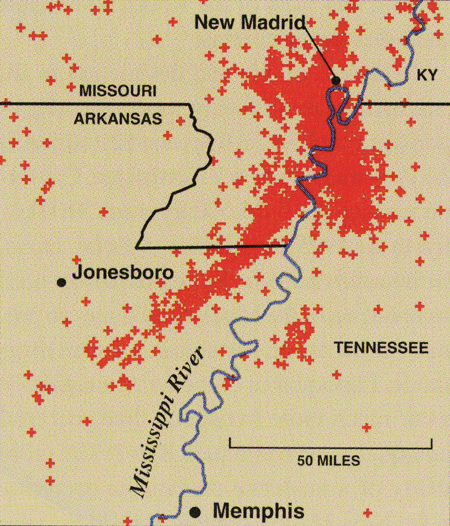Recent Midwest Quakes Called Aftershocks from 1800s

The small earthquakes that sporadically rattle the central United States may actually be aftershocks from a few extremely large quakes that occurred in the region almost 200 years ago, according to a new study
The New Madrid Earthquakes, which struck between December 1811 and February 1812, are some of the strongest seismic events ever to occur in the contiguous United States in recorded history. The largest quake is estimated to have been 8.0 in magnitude and was powerful enough to temporarily make the Mississippi River flow backwards. The heart of the seismic activity was near the town of New Madrid, Missouri, close to the Kentucky and Tennessee borders.
The town has shaken with numerous earthquakes since, from tiny ones that don't cause much of a stir, to moderate sized ones, such as a 5.2 quake in 2008.
Some scientists suspected that many of these events were really repercussions from the big 1811 and 1812 earthquakes. For one thing, "there's no motion across the fault now, so nothing's going on, but yet there are still small earthquakes there," said Seth Stein, the study's lead author and a professor of geological sciences at Northwestern University. The small quakes also occur on the same fault plane that researchers believe is responsible for the big quakes. Furthermore, the present-day temblors are getting smaller with time, which is a characteristic of aftershocks, Stein said. And when larger quakes do occur, they happen at the corners of the fault section that scientists think broke during the 19th century earthquakes, a pattern that suggests these are aftershocks, Stein told LiveScience.
To test this hypothesis, Stein and his colleagues used a set of mathematical equations, called the rock friction theory, which describes how a surface of a fault behaves and is based on lab experiments. They found that the slower a fault moves, the longer the aftershocks are likely to last.
For instance, the San Andreas Fault in California, which moves at the relatively fast speed of about 1.5 inches (3.8 cm) per year, will only have aftershocks for about 10 years after a large quake, Stein said. The fast motion essentially "reloads" the fault, wiping out the effects of a previous earthquake and suppressing aftershocks.
On the other hand, the New Madrid faults, known as the "Reelfoot Rift," move more than 100 times more slowly than the San Andreas fault, allowing the aftershocks to last much longer. The researchers found a similar pattern in faults around the world.
Sign up for the Live Science daily newsletter now
Get the world’s most fascinating discoveries delivered straight to your inbox.
The findings suggest that people may not need to worry so much about the next big quake happening in the New Madrid region anytime soon.
"That fault system seems to be shutting down, and if so, we may be looking at maybe thousands of years before we have [large] earthquakes on that particular fault again," Stein said.
The paper, which was a collaboration between researchers at Northwestern and the University of Missouri-Columbia, will be published in the Nov. 5 issue of the journal Nature.
- The Top 10 Worst U.S. Natural Disasters
- Source of Major Quakes Discovered Beneath U.S. Heartland
- Image Gallery: Deadly Earthquakes

Rachael is a Live Science contributor, and was a former channel editor and senior writer for Live Science between 2010 and 2022. She has a master's degree in journalism from New York University's Science, Health and Environmental Reporting Program. She also holds a B.S. in molecular biology and an M.S. in biology from the University of California, San Diego. Her work has appeared in Scienceline, The Washington Post and Scientific American.









